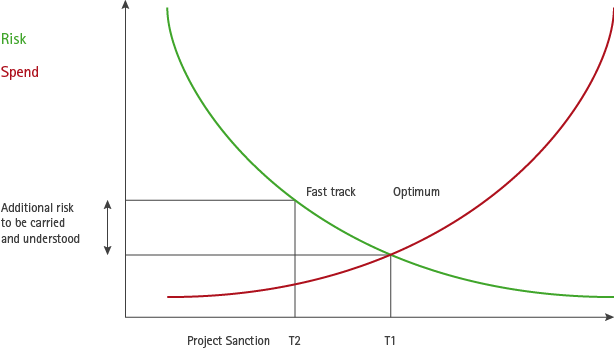Together, the generic work process elements described above comprise EP’s Project Management System. Right from the start, specific elements of project delivery are collected together in a Project Execution Plan (PEP), which evolves into greater levels of detail as the project progresses through its phases.
The contents of a typical EPConsult Energies PEP are:
- Project Specification and Scope (Basis of Design, Field Development Plan)
- Risk register, mitigation and contingency plans
- Criticality assessments
- Project schedules
- Project cost estimates, budget
- Contracting & Procurement Strategy and Plan
- Organisation & Resourcing
- Quality & HSE Plans
- Change management
- Commissioning and Hand-over
- Audit and Review
- Close out
- Reporting
'Fast Track'
Clients frequently aspire to so-called ‘Fast Track’ projects in order that cash flow can commence as soon as possible after investment. The additional risks arising from an accelerated project schedule are illustrated here. EPEn Risk Management work processes can ensure that these risks are identified, understood and managed.

Project phases and associated deliverables
The evolution of the project is phased to reflect the maturity of the development studies, information available, deliverables and residual risk. EP advocates the use of gate reviews to assess and determine the readiness of the project to proceed to the next phase.

Contracting and Procurement
We firmly believe in the tenet that there are very few bad contractors, but there are many bad contracts.
To this end, we advocate an early development of a Contracting and Procurement strategy, and a plan which aligns with project objectives and risks.
Typically, an EP C&P Plan will include:
- Forms of contract and subcontracting
- Review and selection of preferred contracting strategies
- Registration of tenderers
- Host country content
- Fairness/ethics
- Contract award schedule for main contracts
- Initial and screened bidders lists (pre-qualification)
- Tendering/evaluation /contract award procedures
- Partner/joint venturer approvals
- Variations /Claims
- Retention
- Free issue materials
- Single sourcing procedures
- Procurement and Purchasing
Field Development Plan and Basis for Design
The feasibility and conceptual engineering phases aim to:
- Address and resolve technical and economic risks
- Review, screen and document all concepts and options. Frequently, the Opportunity Framing process and review of business objectives and risks, allows a rapid review and screening of concepts, and the rejection of those which clearly do not comply with project objectives
Areas which are typically addressed:
- Process facilities
- Flow assurance
- Process control
- Thermal effects on flowlines and pipework
- Well engineering: annulus, isolation, scale, sand
- Platform and pipeline isolations
- Material selection
- Achieving target Safety Integrity Level (SIL) validation
Early study approach
- Assign EP study leader to the Owner’s project team
- Agree mutual expectations
- Assist or lead, as appropriate, study scope definition, risk assessment, etc
- Package studies for execution by EP team in London
- EP study leader delivers study results and reports to Owner, receives feedback, comments and revisions.
Subsequent design development by a multi-discipline engineering team leads to the Field Development Plan and Basis for Design, developing engineering deliverables, cost estimates and schedules to an increasing level of detail.








